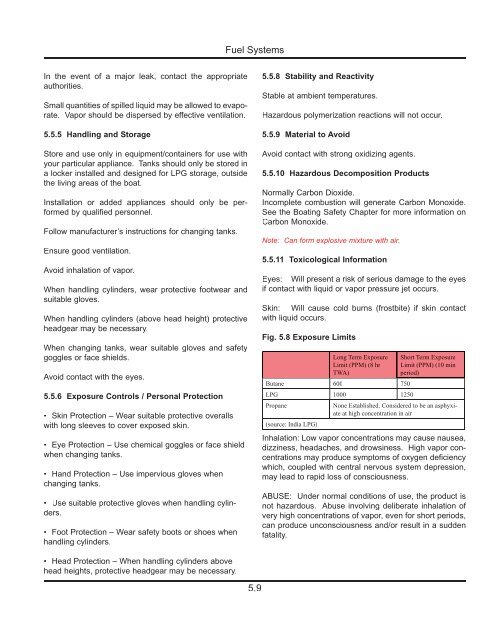36e Operator's Manual 2011.pdf - Marlow-Hunter, LLC
36e Operator's Manual 2011.pdf - Marlow-Hunter, LLC
36e Operator's Manual 2011.pdf - Marlow-Hunter, LLC
Create successful ePaper yourself
Turn your PDF publications into a flip-book with our unique Google optimized e-Paper software.
Fuel Systems<br />
In the event of a major leak, contact the appropriate<br />
authorities.<br />
Small quantities of spilled liquid may be allowed to evaporate.<br />
Vapor should be dispersed by effective ventilation.<br />
5.5.5 Handling and Storage<br />
Store and use only in equipment/containers for use with<br />
your particular appliance. Tanks should only be stored in<br />
a locker installed and designed for LPG storage, outside<br />
the living areas of the boat.<br />
Installation or added appliances should only be performed<br />
by qualified personnel.<br />
Follow manufacturer’s instructions for changing tanks.<br />
Ensure good ventilation.<br />
Avoid inhalation of vapor.<br />
When handling cylinders, wear protective footwear and<br />
suitable gloves.<br />
When handling cylinders (above head height) protective<br />
headgear may be necessary.<br />
When changing tanks, wear suitable gloves and safety<br />
goggles or face shields.<br />
Avoid contact with the eyes.<br />
5.5.6 Exposure Controls / Personal Protection<br />
• Skin Protection – Wear suitable protective overalls<br />
with long sleeves to cover exposed skin.<br />
• Eye Protection – Use chemical goggles or face shield<br />
when changing tanks.<br />
• Hand Protection – Use impervious gloves when<br />
changing tanks.<br />
• Use suitable protective gloves when handling cylinders.<br />
• Foot Protection – Wear safety boots or shoes when<br />
handling cylinders.<br />
5.5.8 Stability and Reactivity<br />
Stable at ambient temperatures.<br />
Hazardous polymerization reactions will not occur.<br />
5.5.9 Material to Avoid<br />
Avoid contact with strong oxidizing agents.<br />
5.5.10 Hazardous Decomposition Products<br />
Normally Carbon Dioxide.<br />
Incomplete combustion will generate Carbon Monoxide.<br />
See the Boating Safety Chapter for more information on<br />
Carbon Monoxide.<br />
Note: Can form explosive mixture with air.<br />
5.5.11 Toxicological Information<br />
Eyes: Will present a risk of serious damage to the eyes<br />
if contact with liquid or vapor pressure jet occurs.<br />
Skin: Will cause cold burns (frostbite) if skin contact<br />
with liquid occurs.<br />
Fig. 5.8 Exposure Limits<br />
Long Term Exposure<br />
Limit (PPM) (8 hr<br />
TWA)<br />
Short Term Exposure<br />
Limit (PPM) (10 min<br />
period)<br />
Butane 600 750<br />
LPG 1000 1250<br />
Propane<br />
None Established. Considered to be an asphyxiate<br />
at high concentration in air<br />
(source: India LPG)<br />
Inhalation: Low vapor concentrations may cause nausea,<br />
dizziness, headaches, and drowsiness. High vapor concentrations<br />
may produce symptoms of oxygen deficiency<br />
which, coupled with central nervous system depression,<br />
may lead to rapid loss of consciousness.<br />
ABUSE: Under normal conditions of use, the product is<br />
not hazardous. Abuse involving deliberate inhalation of<br />
very high concentrations of vapor, even for short periods,<br />
can produce unconsciousness and/or result in a sudden<br />
fatality.<br />
• Head Protection – When handling cylinders above<br />
head heights, protective headgear may be necessary.<br />
5.9

















